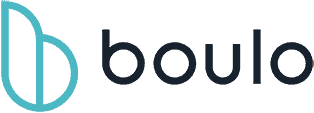LinkedIn, an extensive network of over 950 million members across more than 200 countries, is one of the premier destinations for job seekers and employers alike. Knowing how to post a job on LinkedIn and promoting a job opening on this platform enhances a job’s visibility, increasing the likelihood of attracting a larger pool of potential candidates.
This guide walks you through a step-by-step process to effectively finding high-quality candidates on LinkedIn:
- Step 1: From Your Business Account, Select ‘Post A Job’
- Step 2: Sign in to LinkedIn Talent Solutions
- Step 3: Fill in Job Information
- Step 4: Insert a Detailed Job Description
- Step 5: Select a Method for Receiving Applications
- Step 6: Enter the Company Email Address
- Step 7: Choose Pay Options to Boost The Visibility of Your Job Listing.
- FAQs on How to Post a Job on LinkedIn
- Wrapping It Up
Step 1: From Your Business Account, Select ‘Post A Job’
To begin posting a job on LinkedIn, direct your attention to the ‘For Business‘ icon in the top right corner of your LinkedIn homepage. Click on this icon to reveal a drop-down menu.
Within this menu, look for the “Post a job” button to proceed with posting your job listing.
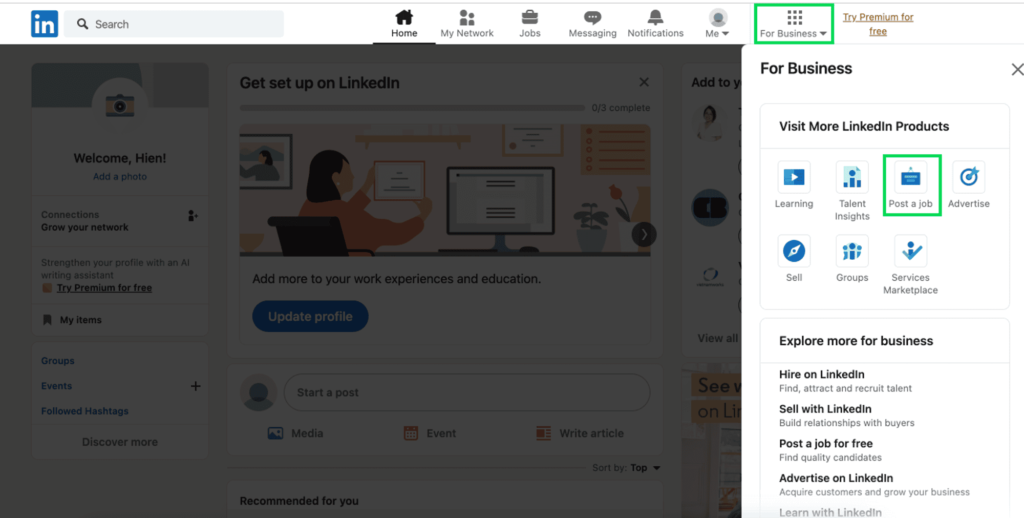
Step 2: Sign in to LinkedIn Talent Solutions
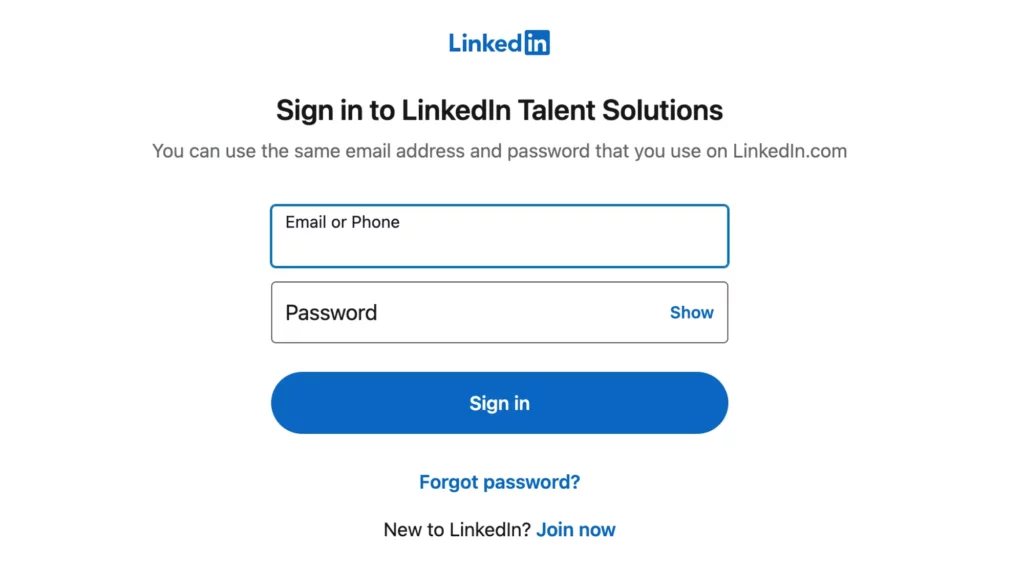
For the next step, access your LinkedIn Talent Solutions account. However, sign up for an account if you don’t have one yet.
This portal is your hub for all things recruitment on LinkedIn, offering a range of features to facilitate your job posting.
Logging in here connects you with LinkedIn’s advanced tools, helping you effectively reach and attract the best candidates for your job opening.
Step 3: Fill in Job Information
This task requires you to enter the specific job information you’re offering, from job titles to job types.
- Job Title: Begin by typing in the job title. As you type, LinkedIn’s auto-suggest function aids in standardizing job titles and enhances your post’s visibility.
This feature assists in reaching candidates actively searching for similar roles, thereby increasing the relevance and reach of your job listing.
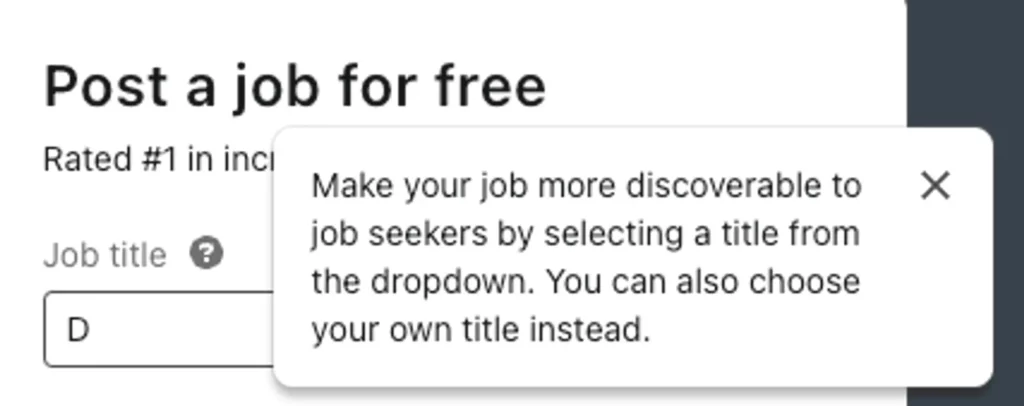

- Company: Input your company’s name next. The auto-suggest function will help you match the company’s name to your LinkedIn company profile for brand consistency.
- Workplace Type: Choose between On-site, Remote, or Hybrid as your workplace type. A clear indication of workplace type attracts applicants who are comfortable with and seeking your specific working conditions, ensuring a better fit.
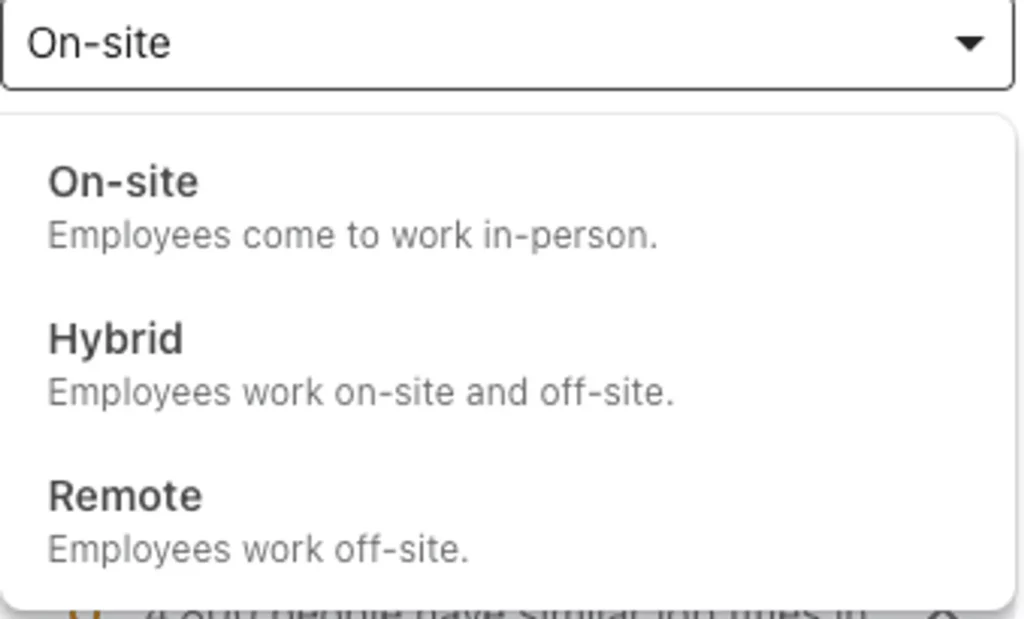
While remote jobs appeal to a broad audience due to their convenience, the flexible work option offers a balance that may be more aligned with your company’s ethos and operational needs.
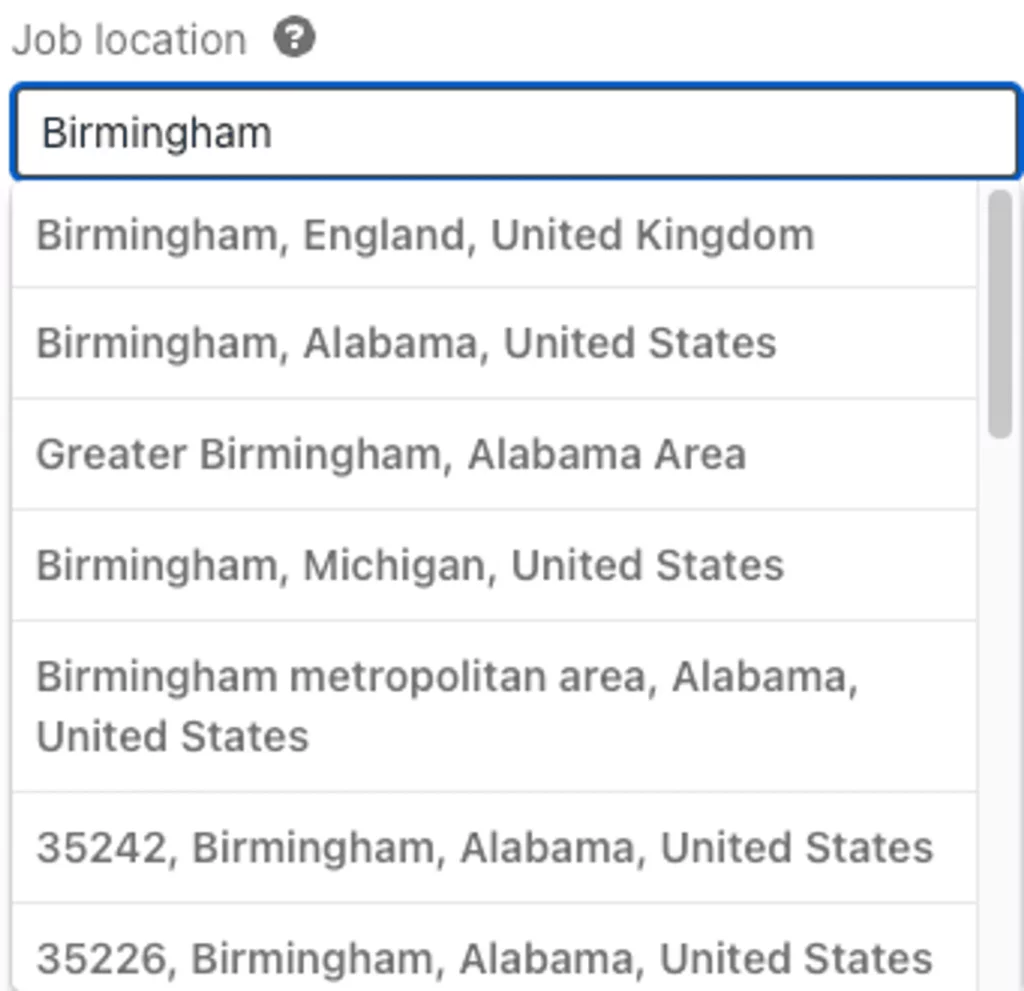
- Job Location: Clearly state the job’s location, focusing on a specific city or metro area to attract local talent and inform potential relocating candidates.
- Job Type: Clearly mark whether the job is full-time, part-time, or permanent, providing candidates with essential information about the nature of the employment and commitment expected.
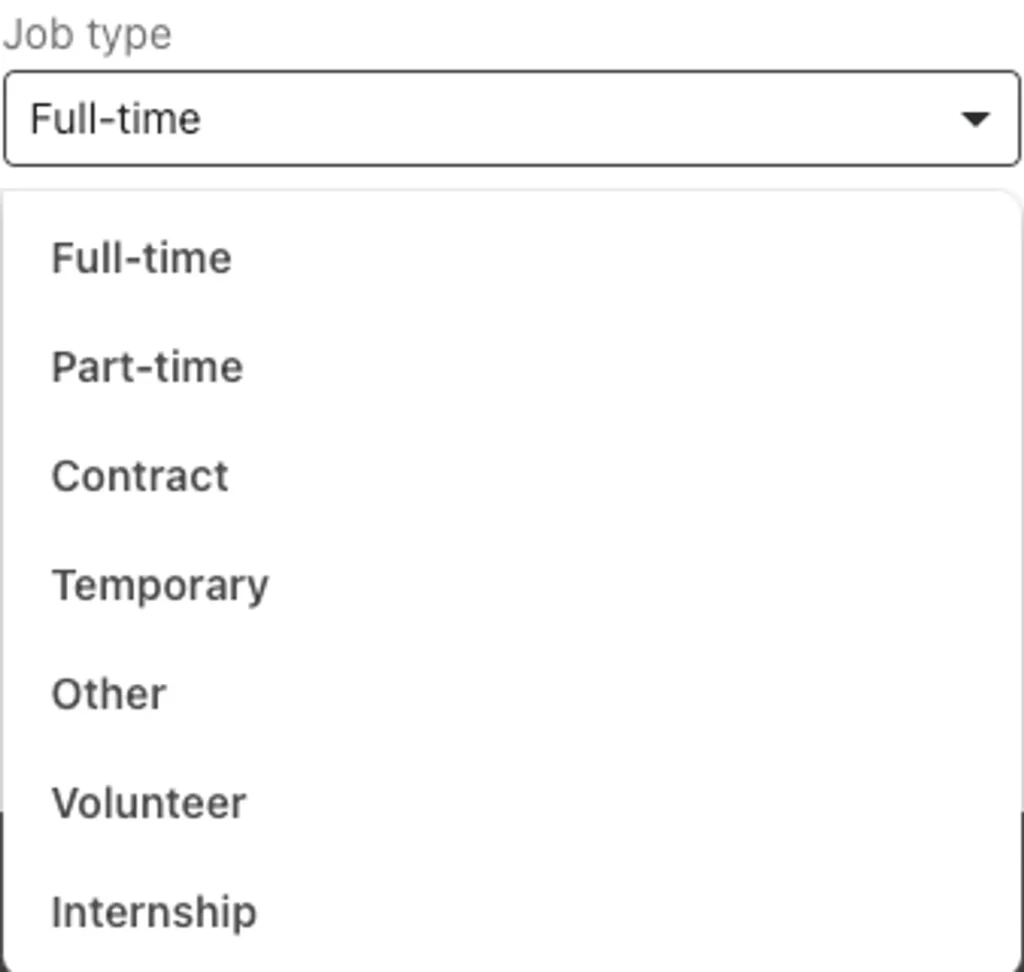
- Full-time: Select this for roles that require a standard full-time schedule, generally 32- 40 hours a week. This option is best for jobs that necessitate a regular, daily presence and typically come with a complete set of employee benefits.
- Part-time: Opt for this classification if the role requires fewer hours than a full-time position, providing flexibility for those who may be handling various responsibilities or seeking a lighter workload.
- Permanent: This term conveys that the job is not temporary or contractual. It implies a steady, ongoing position, offering job security and traditionally associated with many benefits, suitable for individuals looking for long-term career options.
Get insights on hiring independent contractors or employees to make the best staffing choice for your business.
Step 4: Insert a Detailed Job Description
Create the job description by outlining the role’s daily responsibilities, overall goals, and what sets this opportunity apart. Ensure the description is clear and engaging, effectively communicating the job’s essence. Make sure you don’t include and bias inducing language that could exclude key demographics.
- Job Title and Company: Clearly state the job title and your company’s name.
- Workplace Type (On-site, Remote, Hybrid): Specify the nature of the work environment to help the candidates understand the daily working conditions and choose what best fits their lifestyle.
- Job Location and Type: Mention the physical location of the job and whether it’s full-time, part-time, or permanent. This detail aids candidates in determining their ability to commute or relocate and their availability for the role.
- Benefits:
- Health Care (Medical, Dental, and Vision): Highlighting health care benefits shows a commitment to employees’ well-being.
- Retirement Plan: A retirement plan, like a 401K, demonstrates long-term investment in employees’ futures.
- Life Insurance: Offering life insurance adds a layer of financial security for employees.
- Paid Time Off (Vacation and Public Holidays): Emphasize work-life balance by including paid time off.
- Telemedicine: Access to telemedicine services underlines a modern approach to healthcare.
- Short-term Disability: This benefit provides support during unforeseen life events.
- 401K Available: A 401K plan is a valuable component of retirement planning.
- Plus Bonus: Mentioning bonus potential can be a strong incentive.
- Responsibilities and Requirements: Outline the role’s daily tasks and essential qualifications, helping candidates understand the expectations and evaluate their suitability for the position.
- Skills Necessary for the Role: List up to 10 relevant skills. This helps candidates assess their fit and aids LinkedIn’s algorithm in matching your job with suitable profiles.

- Salary Range: A salary range promotes transparency and attracts candidates whose financial expectations align with your offer.
When updating your job description on LinkedIn, use formatting features like bold, italic, and bullet points for emphasis and clarity, and be mindful of word count limits. Utilize LinkedIn’s “Draft new with AI” feature to create a well-rounded and attractive job description.
Step 5: Select a Method for Receiving Applications
The next step involves choosing how you want to receive applications from candidates.
LinkedIn offers 2 primary options: Receiving applications via email or directing applicants to an external website.
- Option 1: Receiving candidate information through email:
Here’s how togathering applicant details via email.
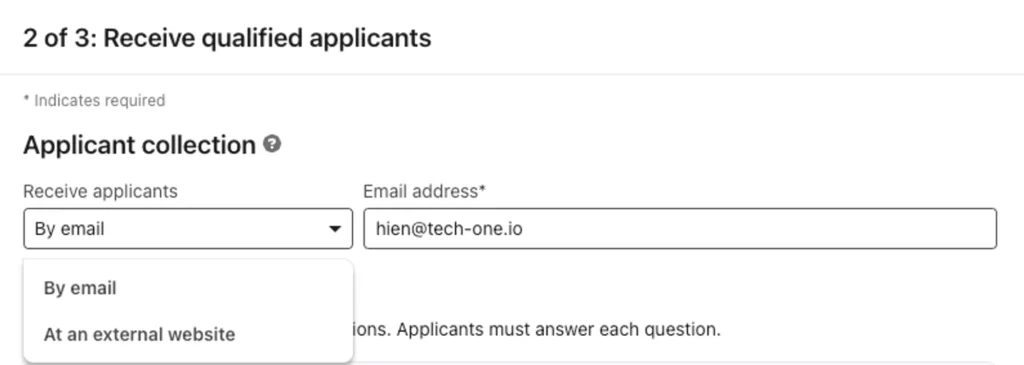

If you opt to receive applications by email, you’ll enter a stage where you can set up screening questions as below.
Moreover, the “Must-have qualification” function on LinkedIn enhances the screening process.
LinkedIn activates a “Candidate selection by filtering” function when you mark a screening question as a must-answer. This automatically filters out applicants who don’t meet these essential qualifications and can send rejection notifications to them. However, this feature is optional and can be turned off if you prefer a more hands-on approach to candidate selection.
- Option 2: Receiving candidate information through an external website
This option will direct applicants to an external site, like your company’s career page or a third-party application system.
This redirects candidates from LinkedIn to your chosen platform for their application submissions, helping to centralize and manage the recruitment process.
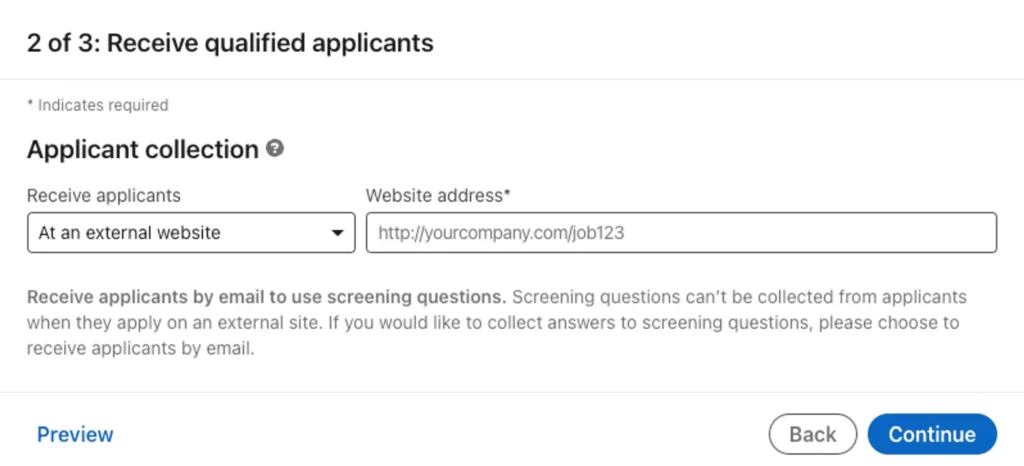
After completing the job description, click ‘Continue’ to progress to the next stage of your job posting.
Step 6: Enter the Company Email Address
Next, enter your company’s email address, where you’ll get all the responses from candidates applying for the job.
This way, everything related to your job post is in one place, making it easier to keep track of applications and follow up with candidates.

Step 7: Choose Pay Options to Boost The Visibility of Your Job Listing.
The final step involves deciding your job post’s promotion strategy; you can choose either the Free or Promote plan.
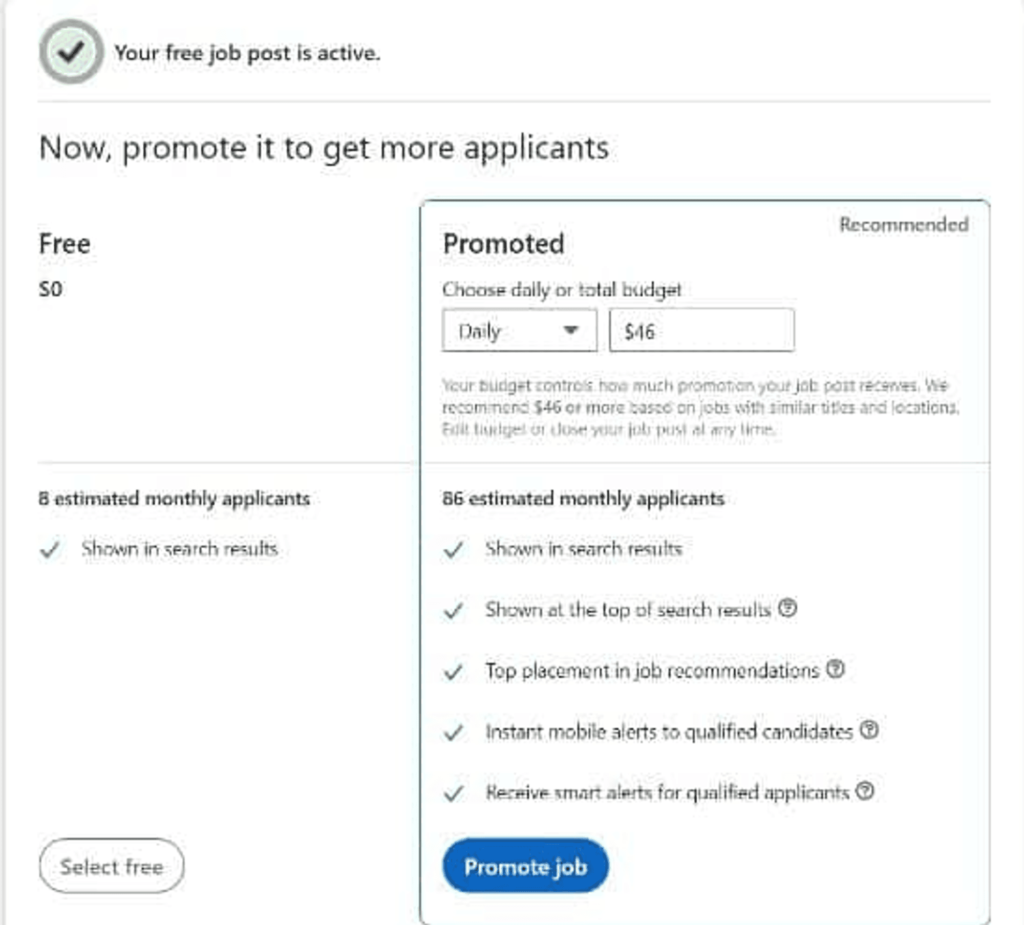
The Free plan allows you to post your job without any cost, relying on organic reach within LinkedIn’s network. There are some significant limitiation that effect the visibility of your job on this plan.
On the other hand, the Promote plan involves investing in attracting a wider pool of candidates. This option is ideal if you’re looking to increase the reach and impact of your job posting rapidly.
Remember, your post is competing millions of other jobs.
FAQs on How to Post a Job on LinkedIn
Let’s dive into some of the most common questions you might have about posting jobs on LinkedIn.
1. What is the difference between a free and a paid job post on LinkedIn?
The choice between free and promoted job posts on LinkedIn affects the visibility and reach of your listing. Free posts provide basic exposure, while promoted posts enhance visibility and applicant quality; therefore, let’s shed light on the differences:
| Aspect | Free Job Posts | Promoted Job Posts |
| Visibility | Visible in search results and among LinkedIn connections. Limited to one open free job post at a time. | Top of search results with a “Promoted” tag, and prime placement in “Based on Your Profile” and “Similar Jobs” sections. |
| Search Results | Discoverable on LinkedIn, ensuring basic exposure. | Appear in highly visible placements in job recommendations. |
| Applicant Management Tools | LinkedIn provides tools to filter and manage applicants. | Advanced tools plus instant mobile notifications and smart alerts for qualified applicants. |
| Qualified Applicants | Basic level of applicant reach. | Attracts three times more qualified applicants than free posts. |
| Duration and Exposure | Visible for 21 days, with decreasing visibility quickly and gets paused after a certain number of applications. | Stays active for up to 6 months or until closed, with no cap on the number of applicants. |
| Additional Features | Limited to basic visibility and applicant management tools. | Instant mobile alerts to local candidates and matching algorithms for identifying suitable applicants. Prime placement in job recommendations for targeted visibility. |
2. How much does it cost to Post a Job on LinkedIn?
While posting a job on LinkedIn is free, opting for a promoted post for better visibility can be costly.
A 30-day campaign with a $10 daily budget can amount to $300 or less, varying with the ad’s reach, which can be a significant expense for SMEs.
Alternatively, Boulo’s Grow Package offers a more economical solution at $289 monthly, including unlimited job postings, 360° candidate profiles, effective communication tools, quick interview scheduling, and professional support. It’s a budget-friendly and efficient choice for SMEs to connect with a diverse and qualified pool of candidates.
3. How can we ensure our job postings are inclusive?
Ensuring inclusivity in your job postings starts with mindful language in descriptions and diversifying where you post. For small and medium-sized businesses aiming to enhance their recruitment reach, Boulo can be a strategic choice.
Specifically, Boulo offers unique customized plans for various budgets of small and medium-sized businesses. Also, it connects employers with a diverse pool of experienced professionals, including women and caregivers with over 10 years of experience in their fields. This approach supports your inclusivity goals and broadens your access to talented candidates who are eager to contribute to your company’s growth and diversity.
Wrapping It Up
Every business aims to build a team that’s both dynamic and in tune with its goals, and a significant part of that journey involves effective recruitment strategies. Therefore, knowing how to post a job on LinkedIn paves the way for employers to connect with a vast talent pool.
For those seeking a more customized approach, especially for small and medium-sized enterprises, Boulo is a valuable partner, offering a hiring process attracting diverse candidates and enhancing your recruitment efforts. By posting a job with Boulo, you’re opening doors to finding the ideal candidates for your team.
